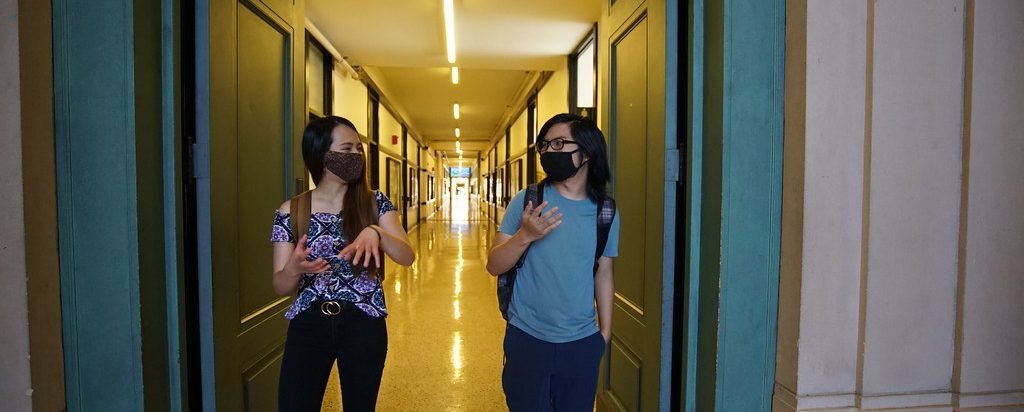Preparing to teach with masks

Effective 10 February 2022, the “One-Mask-Down-at-a-Time” Policy applies in MIT classrooms and other learning spaces. The policy states:
“When speaking in a group setting where all others present are masked (e.g., a faculty member, instructor, or TA giving a lecture; a guest speaker at an event; a student asking a question in class; a staff member making a comment in a meeting), a fully vaccinated speaker may lower or remove their mask while speaking and then raise or replace their mask to allow others to speak.”
MIT guidelines on face coverings
As in previous semesters make sure to be patient with yourself and with your students. Ask your students to be patient with you. We’re all going through this together!
The items below provide suggestions to support both teaching and learning with masks.
Wear a mask that allows you to move your mouth and lips easily while remaining protected. You may want to consider a sport cage insert that creates more room under the mask, but make sure your mask fits well over the cage and doesn’t have gaps. Note: Research suggests that clear masks interfere with audibility more than others. Learn more about the effects of masks on audibility here.
Project your voice. Use a microphone or personal amplifier to project your voice while allowing you to continue wearing a mask. Use a lavalier mic or personal voice amplification device ([1] or [2]) attached to your collar, lapel, or lanyard around your neck. Lavalier mics should not be close to your mouth. It will function best if you position the mic near your collarbone about a hand-span distance (20-30cm) from the mouth. Never hold the mic in front of your mouth or place it against the mask material — sound quality will be distorted because of the closeness to the audio source.
MIT A/V equipment and space assessments
- Equipment
- wireless handheld mics
- clip on lavalier (hands-free) mics
- push-to-talk goose-neck tabletop microphones (to facilitate student communication)
- Space assessments
- determination of compatible equipment
- deployment of required gear
To request equipment and/or services, please complete the MIT AV request services form.
IS&T Loaner Equipment Program for Faculty & Staff
To request loaner equipment from IS&T please complete the Loaner Request Form.
Adjust your delivery
Whether masked and/or amplified, you will need to adjust your usual way of speaking:
- If you don’t have a microphone, speak just a little bit louder than you normally would. Without a microphone, you will also want to avoid talking while facing the board — practice writing on the board and then speaking. Some may find the silence awkward, but with practice it will feel more normal. Don’t be afraid of small silences.
- More important than volume are speed and clarity: slow down just a little more than you normally would speak and enunciate carefully to help the students process what you’re saying.
- Add body language and facial expressions and consider vocal tone to help get your message across. Smile under your mask — a smile is reflected in your eyes and in your tone of voice. Remind your students to do the same: regularly ask them to project their voice so that you and others in the classroom can hear.
Protect your voice. Slowing down and using a microphone will help, but it is also important to avoid straining your voice. Some suggest diaphragmatic breathing to project your voice and avoid strain.
Prioritize recovery. If you teach for a long stretch of time or teach multiple courses on a single day, schedule regular voice breaks throughout the day and drink water whenever possible.
Practice. Don’t wait until the first day of class to see how it feels to teach while wearing a mask.
All these adaptations and adjustments can require great amounts of effort and be exhausting. For resources and services that support wellness at MIT, see here.
Check in with students
- Check with students that they can hear and understand. Pay particular attention to students who are deaf or hard of hearing. Encourage them to contact Disability and Access Services if they need assistance.
- Ask your students to interrupt or wave, if they can’t hear you, and/or would like clarification or additional explanation.
- Consider adopting signals that students can use to indicate that they cannot hear you (e.g., a tug on the ear); and that they don’t understand (e.g., hand on their heart, or both hands face up in front of their chest) – the latter can replace a puzzled look (which may be obscured by a mask). Set these norms the first day of class and state them clearly in the syllabus. Alternatively, you can involve students in creating their own community guidelines for communication. TLL also has guidelines for creating discussion guidelines as a class.
- Repeat students’ questions to the entire class after someone asks a question. It will be more difficult for students sitting in the back of a crowded classroom to hear their peers.
- Check in with your students more regularly and ask for in-class feedback: ask for a thumbs-up or a head nod.
- Encourage “active listening” in seminars where people confirm what they heard before adding the next point. It may be necessary to remind people that listening is all the more important when there aren’t visual cues to rely on. They’ve been wearing masks for months and months, but not everyone has taken an in-person class with everyone wearing masks. The listeners will have to engage more, as well as the speakers working to connect more.
- Consider more regular check-ins and anonymous mini-surveys. During the last (or first) 3-5 minutes of class, distribute index cards or half-sheets of paper and have students anonymously reflect on the “muddiest” point from the class; or answer the questions “How’s it going? How can I help? MUD cards encourage students to actively process what happened during class and to reflect on their understanding. Students hand in the MUD cards before leaving class, allowing you to review them and address muddy points in the next class meeting, during office hours, or electronically. A template for an after class MUD (Most Unclear Discussion) Card can be found here, or just provide blank index cards for student feedback.
- Gather mid-semester feedback from students about the subject, in general, and include a few questions specifically about how masking and other COVID protocols are affecting students’ experience of the classroom. Do they have suggestions for how you might communicate with each other more effectively? Suggestions and templates to collect mid-semester feedback can be found in the Teaching + Learning Lab’s Assess & Improve your Teaching pages. The forms can be modified to include your specific needs and questions.
Build community while masked
- Create an introductory video for the class. You can share a bit about yourself and let students see you without your mask. Share the video with them before the first day of class. In addition, you can use the video to run through class expectations and other syllabus tasks can also reduce the number of times you need to explain something during the first weeks as people drop and add.
- Learn your students’ names and help students get to know each other. Ask students to create a name card that can be seen by you (and others in the class – if the classroom layout permits). You can distribute blank index cards on the first day of class for the name cards and ask them to add to it: sketch a picture of themself in a mask or add features (or words) that will help you recognize them during class.
- Ask your students to identify themselves when they talk.
- In smaller classes, have everyone introduce themselves with memorable information or create ice breaker activities to get to know each other.
- In larger classes, break into small groups for the get-to-know-you activities. You may want to do this for a couple of minutes at the start of class for several weeks so more people have a chance to interact with others. Other ideas might be to encourage more “personalized” masks or even visible name tags.
- Accurate name pronunciation helps create a more inclusive classroom, but student names will be harder to hear and pronounce accurately while wearing masks. Consider using a service like namedrop to allow students to share their name pronunciations without masks and to give you multiple opportunities to listen and practice.
- You may find it useful to create connections between yourself and your students, as well as between students, by assigning a short “introduction video” to each student. Students can use flipgrid to record and share brief videos within the class.
Offer alternatives to auditory information
Build-in opportunities for non-vocal communication (this may require that students bring laptops or other web-enabled devices to class). Use apps or software that allow students to ask questions through a backchannel (analogous to the “chat” function in Zoom).
Beyond software and apps relevant to your specific subject or discipline, we recommend exploring:
- Slido. Allows students to post questions, see the questions of others, and upvote questions from their peers that they also have. You (and your TAs) can view all questions – and reply, as appropriate during class.
- A shared Google doc (click here to create a copy of a doc that can be distributed via link – wherein students can submit questions in real-time, during class.
- Polleverywhere and a range of other quizzing or polling software.
- For small group, in-class work, incorporate collaborative software/apps like:
- Explain Everything (MIT supported)
- Mural (MIT supported)
- Slack (MIT supported)
- Google docs (MIT supported)
For all class sizes, it can also be helpful to use images, charts, tables, and other multimedia to help reinforce content.
Adopt online office hours
Offer online office hours (Bonus: No masks needed!) over Zoom where you and your students can talk without masks.
If you are finding students reticent to attending Zoom office hours, offer some extra bonus points in grading for attending. If you have lots of students wanting to attend, consider offering sign-up slots for specific times.
Additional Resources
- This brief audio article from Illinois State University has advice from a speech pathologist and director of the institute’s teaching center.
- Effective ways to teach in person with a mask on (opinion), Inside Higher Ed, 26 August 2020.
MIT Resources
- MIT NOW
- Face Covering Resources
- Face Covering Criteria from EHS
- Getting the most from your mask, Jill Crittenden, Ph.D. Scientific Advisor, McGovern Institute for Brain Research – MIT
- MIT AV
- IS&T
- MIT – Open Learning
For additional support, email covidclasshelp@mit.edu.
Adapted for MIT from the University of Michigan Center for Research on Learning & Teaching: 23 tips and tricks for teaching with masks.

